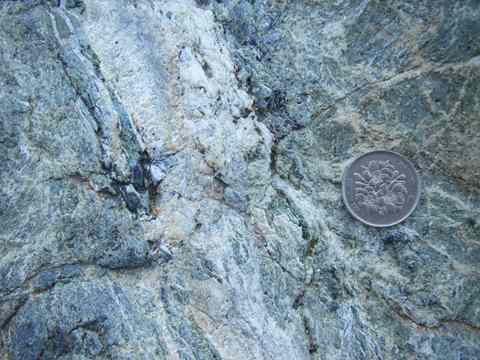Miyazawa
Nogami-Shimogo, Nagatoro city, Chichibu county, Saitama pref., Japan
Synonym
Higuchi
Occurrence
Greenschist facies serpentinite
Serpentinite included in Sanbagawa Metamorphic Rocks. This serpentinite block is lens-shaped and is concordant with schistosity of Sanbagawa Metamorphic Rocks. This serpentinite block contains dolomite-talc veins. The origin of this serpentinite block is considered as sedimentary serpentinite mélange from serpentinite seamounts at the fore-arc slope.

Outcrop of a white dolomite-talc vein in a serpentinite block associated with Sanbagawa Metamorphic Rocks. The massive white parts are dolomite, and the fibrous pale brown parts at the upper left are talc. Talc is at the boundary between dolomite and serpentinite, and its fibers are vertical to the vein wall. Gold has been recovered from this dolomite vein. It is considered that the dolomite-Talc veins were formed by the reaction of CO2 fluid with serpentine in fissures:
2Mg3Si2O5(OH)4 (Serpentine) + 3CO2 >> Mg3Si4O10(OH)2 (Talc) + 3MgCO3 (Magnesite component in Dolomite) + 3H2O
On the other hand, massive talc deposits in serpentinite block can be explained by the reaction of serpentine with SiO2.
Reported Minerals
- Talc
- Dolomite
- Gold
- Scheelite
Mineral Assemblages
- Dolomite - Talc
Localities
- Orihara (Talc, High-P)
- Matsunaga Mine (Talc, High-P)
- Arai (Diopside, High-P)
- Osaka (Ophicalcite, High-P)
- Miyazawa (Dolomite, High-P)
- Onara (Fe-Ni, High-P)
- Yashio mine (Fe-Cr, High-P)